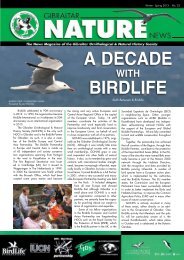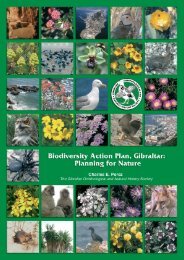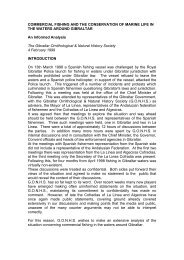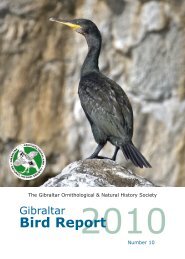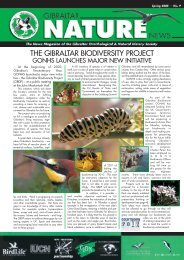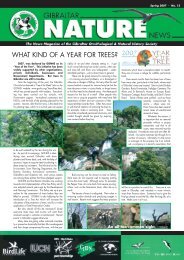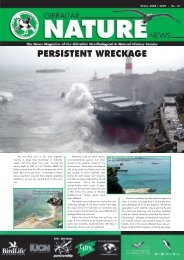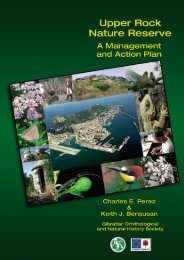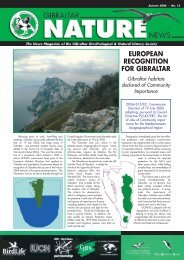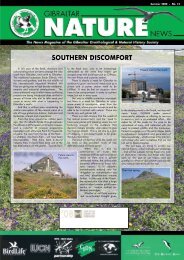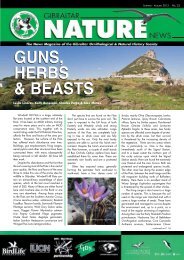ure News 11 - Gibraltar Ornithological & Natural History Society
ure News 11 - Gibraltar Ornithological & Natural History Society
ure News 11 - Gibraltar Ornithological & Natural History Society
You also want an ePaper? Increase the reach of your titles
YUMPU automatically turns print PDFs into web optimized ePapers that Google loves.
1ST INTERNATIONAL CAVE MONITORING FIELD WORKSHOP<br />
Jointly organised by Royal Holloway, University of London, University of Innsbruk<br />
and the <strong>Gibraltar</strong> <strong>Ornithological</strong> and <strong>Natural</strong> <strong>History</strong> <strong>Society</strong>.<br />
Monitoring headquarters, St Michael’s Cave<br />
In February, GONHS will be hosting the worlds<br />
first International Cave Monitoring Field Workshop.<br />
This will be a four-day event bringing cave and climate<br />
science specialists from all over the world to<br />
<strong>Gibraltar</strong>. Climate change studies have been a hot<br />
topic now for quite a few years involving different<br />
approaches to understand what the climate was like<br />
in the past. <strong>Gibraltar</strong> is in a uniquely important location<br />
to carry out this research not only because of its<br />
geographical location at the junction between two<br />
continents and two oceans but also because of the<br />
abundance of caves containing stalagmite records of<br />
past climates and long history of weather recording<br />
since the 18th century.<br />
Scientists involved in climate studies use a range<br />
of different specialised fields to uncover the past. For<br />
example, botanists can use tree rings to get a climate<br />
record over the last few millennia, scientists in polar<br />
regions take very long ice core samples spanning tens<br />
of thousands of years which provide a record of the<br />
atmosphere when the snow and ice were formed.<br />
Exactly the same happens when a stalagmite in a<br />
cave grows. The “rings” in a stalagmite corresponds<br />
to a layer of growth in the life time of the speleothem<br />
and may record the rainfall over periods spanning<br />
many seasons to individual storms. Stalagmites, like<br />
ice cores, tree rings, mud cores and even human hair,<br />
record a detailed record of what the environment was<br />
like when they grow undisturbed, sometimes over<br />
hundreds of thousands of years. The problem with<br />
most ‘proxy’ climate records such as pollen, tree rings<br />
etc. is that while they reveal general trends in climate<br />
(warmer-cooler, wetter-drier etc) they do not provide<br />
hard data (temperat<strong>ure</strong>s, rainfall amounts, weather<br />
patterns) that the climate modellers (the scientists that<br />
provide the all important predictions of the fut<strong>ure</strong><br />
weather) badly need. Stalagmites are one of the only<br />
proxies that have the potential to do this but only if it<br />
is known how the cave temperat<strong>ure</strong> and groundwater<br />
responds to different weather patterns.<br />
In 2004 The Royal Holloway University of<br />
London in partnership with the GONHS initiated an<br />
innovative research program on how a caves really<br />
work and how accurately stalagmites record the past<br />
climate. The study, supported by the UK <strong>Natural</strong><br />
Environment Research Council, initially focussed on a<br />
small sample of a stalagmite from New St Michaels<br />
cave was taken to the hi-tech research laboratories in<br />
the Earth Sciences Department at Royal Holloway.<br />
Using laser systems and computer controlled<br />
micromilling instruments the isotopic record of the<br />
sample was investigated at the highest resolution ever<br />
made and provided the first ever record of monthly<br />
variations in growth of an active speleothem which<br />
could be accurately related to the weather above the<br />
cave.<br />
At the same time data logging systems were<br />
deployed in and around the cave, and in the soil horizons<br />
above the cave, to record temperat<strong>ure</strong>s, humidity,<br />
groundwater flow and air compositions. These<br />
systems have been managed by<br />
the Caves and Cliffs section of<br />
GOHNS who also carried out regular<br />
monthly sampling of groundwater<br />
and air for further analysis.<br />
Some of the gadgets needed, such<br />
as drip counters, carbon dioxide<br />
sensors and loggers were specially<br />
designed for this project and have<br />
provided data that have never<br />
been obtained for a cave system<br />
anywhere else in the world. Along<br />
with cave monitoring, the project<br />
has accrued numerous other firsts,<br />
ranging from using the latest techniques<br />
for analysing and imaging<br />
stalagmites at the European<br />
Synchrotron Facility in Grenoble,<br />
and resurveying the St Michaels<br />
system by precision laser scanning<br />
which is producing a highly accurate<br />
3-D computer model of the<br />
caves.<br />
After four years of hard work<br />
we have been able to show that<br />
cave monitoring is essential in<br />
order to understand the links<br />
between weather events and how<br />
these are recorded in stalagmites.<br />
The results of this research have<br />
provided some very interesting and<br />
sometimes unexpected results. We<br />
have found that cave ventilation is<br />
one of the most important controls<br />
on stalagmite growth and New St<br />
Michaels cave, takes two breaths a<br />
Kevin Dixon using a laser scanner<br />
to image the Lake Chamber<br />
year: it inhales in winter and exhales in summer. This<br />
has huge significance to the way stalagmites record<br />
climate and was only discovered whilst doing the<br />
study. Another important part of the project is understanding<br />
the passage of water as rain into the cave.<br />
The calcite that forms into a beautiful stalagmite is<br />
brought in by rainwater that has picked up carbonic<br />
acid as it travels through soil and dissolves rock along<br />
bedding planes, and deposits the calcite on the stalagmite<br />
has a new layer. Knowing exactly how long it<br />
took that rain water to appear in the cave is therefore<br />
important. For example, in an area of the cave we<br />
have sites just a few meters apart that respond completely<br />
differently – one has a response time to rain of<br />
only 6 hours others responds far more slowly. At<br />
another site water is now known to pass though a<br />
siphon type reservoir, indicating that the water is<br />
being stored before reaching the cave. All of these<br />
different responses meas<strong>ure</strong>d across 4 years of monitoring<br />
have important effects on the way the<br />
speleothem grows and records climate.<br />
<strong>Gibraltar</strong> is now at the forefront of this field of<br />
research and in February we will be welcoming the<br />
cave science community from the US, Australia and<br />
all over Europe to discuss monitoring techniques and<br />
interpretation of climate records in cave deposits. A<br />
highlight of the meeting will be underground visits to<br />
see the cave monitoring systems running and gathering<br />
data which have now achieved international<br />
recognition.<br />
References<br />
Mattey, D., Latin, J.-P. and Ainsworth, M. Cave<br />
monitoring and calibration of a δ18O – climate<br />
transfer function in <strong>Gibraltar</strong>, PAGES <strong>News</strong>letter,<br />
16(3): 15-17, 2008<br />
GIBRALTAR NATURE NEWS<br />
<strong>11</strong>



